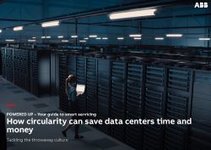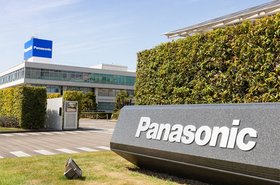One estimate suggests that every person on the planet creates 1.7 MB of new information every second. This makes data centers one of the fastest-growing and largest contributors to the global economy. And there’s no sign of it slowing. By 2025, the global data center market is expected to expand more than 18 percent annually, reaching $250 billion.
This accelerated growth comes with accelerated demand—fueled by AI, automation, and cryptocurrency. According to the International Energy Agency, data centers worldwide consume upwards of 250 terawatt-hours (TWh) of electricity, representing around one percent of global electricity demand and 0.3 percent of global carbon emissions. That number is expected to reach eight percent by 2030.
Data centers find themselves tasked with managing their rapid growth while adopting more sustainable energy practices to reduce their expanding carbon footprint. To meet this challenge, stakeholders must start prioritizing and preparing for an energy-efficient future, now.
Mounting pressures to maximize efficiency
The mounting pressure on data centers to embrace sustainability starts with the volatile energy market. Between 2021 and 2022, U.S. gas prices jumped nearly 50 percent, resulting in a 34.6 percent increase in energy prices. As significant energy consumers, data centers are feeling the impact of these price hikes on their bottom lines, along with the urgency to do something about it.
Pressure to adopt more sustainable practices also comes from ever-more aggressive government regulations. On January 1, 2023, the US Department of Energy (DOE) established stricter nationwide requirements for HVAC equipment so essential to data center operations. And in 2024, the SEC is expected to rule on requiring data centers to disclose greenhouse gas emissions and other climate-related risks. Additional new government mandates are likely to require data centers to not only measure their carbon footprint but demonstrate how they plan to reduce it.
Data center operators also feel public pressure from their customers. In one survey of American consumers, 87 percent of respondents said they would prefer to buy from companies that provide social and environmental benefits, and 92 percent said they are more likely to trust companies that address environmental concerns. Going green is good for business as well as the environment. Data centers should be taking notice of this.
Overcoming energy efficiency obstacles
Data centers need energy — and lots of it — to keep their facilities up and running at peak capacity around the clock. They use up to 50 times more energy per square foot of floor space than a commercial building. Around 50 percent of typical data energy consumption is from the IT equipment, and an estimated additional 35 percent is consumed by the HVAC equipment. Stakeholders who operate older data centers often rely on diesel-powered backup generators that create a significant carbon impact as well.
The need for more efficient energy management in data centers is clear. What’s less clear is how data center stakeholders can go about reducing their energy consumption without disrupting their operations or breaking their budget. Given this multi-pronged challenge, many stakeholders are understandably reluctant to push sustainability to the top of their priority list. According to the Uptime 2021 Global Data Center Survey, while 82 percent of data center managers track electricity usage and 70 percent monitor power usage effectiveness (PUE), only one-third monitor their carbon impact.
The cost of making the necessary technology investments seems to be one of the biggest obstacles for data center energy reduction. In a 2023 Data Center & Infrastructure survey, stakeholders identified new technology adoptions as their third most pressing challenge — behind security risks and a shrinking workforce. As a result, data center operators are tasked with squeezing as much life as possible from their existing equipment and systems, rather than replacing them with new energy-efficient technologies. In that same survey, stakeholders also identified extending equipment life (39 percent) as their top sustainability goal, with only 16 percent of respondents identifying reducing energy consumption as a priority.
Given the reluctance and concerns around adopting new technologies and systems to improve energy efficiencies, what options do data center stakeholders have? The answer can be found in better building energy management.
Yes, data centers are complex. While this poses a challenge, it also means there are myriad opportunities to find and capture energy efficiencies across data center facilities. Proactive, forward-looking stakeholders are exploring and embracing a wide range of technology innovations to help them meet government requirements and public demand, while keeping costs in check. Many of these innovations involve retrofits and upgrades, as well as finding the opportunities to reduce energy usage in existing systems across the facility. Here’s a good place to start.
Energy-efficient cooling and storage
Large data centers use about 35 percent of their energy simply to keep their servers cool. To drive down that number, data center stakeholders are employing an array of cooling innovations, including underfloor air-distribution systems, high-efficiency chillers and cooling towers, closely coupled cooling and heat removal, and better coordination of existing air conditioners. A Gartner report predicts that by 2025, data centers that adopt specialty cooling techniques like these will see a 20 percent to 40 percent reduction in operating costs. Options include:
- Immersion cooling, in which servers are submerged in nonconductive liquid coolant, representing among the most efficient, reliable, and scalable methods.
- Variable speed fans, which can generate a 20-25 percent reduction in fan energy requirements.
- Control loops that manage temperatures at the most critical point on the rack, set to supply only as much air as the given space requires. Raising temperature set points can also reduce rack energy requirements as well as the size of the HVAC unit needed to cool the space.
- Centralized air handlers installed with a central system to help improve efficiency and reduce maintenance requirements.
- AI-powered cooling and machine learning that determines and applies the optimal amount of cooling needed at any given time — generating up to a 40 percent reduction in cooling costs.
Diesel genset backup power supply systems present another significant source of energy consumption and emissions, especially for older data centers. Forward-looking data centers are exploring options to replace these polluting generators with battery energy storage systems (BESS), a new emission-free technology that uses lithium-ion batteries that come with lower capital and operational expenses. While not as scalable as lithium-ion batteries, flow batteries offer data centers another more efficient option by storing energy in tanks of electrolytes and holding their charge indefinitely.
Do it now
Despite concerns, data center stakeholders have myriad compelling reasons to take action now to improve their energy management and reduce energy usage. Industry experts agree that data center operators who react the fastest to improve efficiency stand to benefit the most, especially given that sustainability has become a top priority for many leading companies.
Take Microsoft, which announced its intention to eliminate all greenhouse gas emissions in its facilities and supply chain by 2030. Amazon Web Services and Google are on board as well, with the former announcing plans to power its operations with 100 percent renewable energy by 2025 and the latter stating its goal to operate carbon-free by 2030. Other data center operators are following in their reduced-carbon footsteps.
Data center stakeholders who are slow to progress toward sustainability will quickly be left behind. By taking steps to improve building energy management now, data centers are also future-proofing their operations with an infrastructure that’s ready to withstand the combined strains of climate change, government regulations, and public perception.
For data center stakeholders who are still reluctant to prioritize energy efficiency due to complexity and costs, there are practical and incremental steps that can ease the transition, minimize disruption, and lower capital outlays. There are also multiple sources of funding to help lighten the financial burden, including federal and local incentive programs, green loans, decarbonization programs, equipment rebates, energy procurement contracts, and power purchase agreements.





